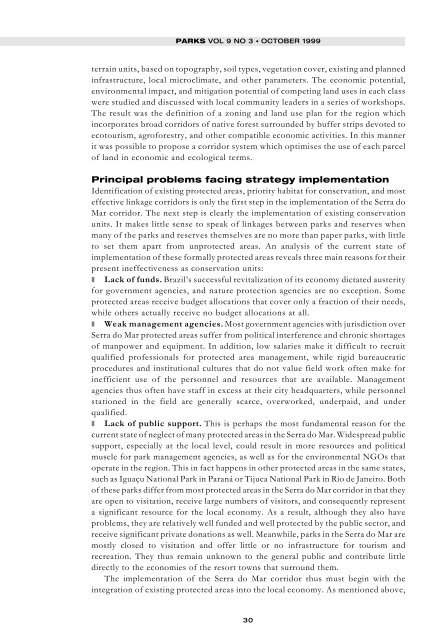Parks - IUCN
Parks - IUCN
Parks - IUCN
Create successful ePaper yourself
Turn your PDF publications into a flip-book with our unique Google optimized e-Paper software.
PARKS VOL 9 NO 3 • OCTOBER 1999<br />
terrain units, based on topography, soil types, vegetation cover, existing and planned<br />
infrastructure, local microclimate, and other parameters. The economic potential,<br />
environmental impact, and mitigation potential of competing land uses in each class<br />
were studied and discussed with local community leaders in a series of workshops.<br />
The result was the definition of a zoning and land use plan for the region which<br />
incorporates broad corridors of native forest surrounded by buffer strips devoted to<br />
ecotourism, agroforestry, and other compatible economic activities. In this manner<br />
it was possible to propose a corridor system which optimises the use of each parcel<br />
of land in economic and ecological terms.<br />
Principal problems facing strategy implementation<br />
Identification of existing protected areas, priority habitat for conservation, and most<br />
effective linkage corridors is only the first step in the implementation of the Serra do<br />
Mar corridor. The next step is clearly the implementation of existing conservation<br />
units. It makes little sense to speak of linkages between parks and reserves when<br />
many of the parks and reserves themselves are no more than paper parks, with little<br />
to set them apart from unprotected areas. An analysis of the current state of<br />
implementation of these formally protected areas reveals three main reasons for their<br />
present ineffectiveness as conservation units:<br />
❚ Lack of funds. Brazil’s successful revitalization of its economy dictated austerity<br />
for government agencies, and nature protection agencies are no exception. Some<br />
protected areas receive budget allocations that cover only a fraction of their needs,<br />
while others actually receive no budget allocations at all.<br />
❚ Weak management agencies. Most government agencies with jurisdiction over<br />
Serra do Mar protected areas suffer from political interference and chronic shortages<br />
of manpower and equipment. In addition, low salaries make it difficult to recruit<br />
qualified professionals for protected area management, while rigid bureaucratic<br />
procedures and institutional cultures that do not value field work often make for<br />
inefficient use of the personnel and resources that are available. Management<br />
agencies thus often have staff in excess at their city headquarters, while personnel<br />
stationed in the field are generally scarce, overworked, underpaid, and under<br />
qualified.<br />
❚ Lack of public support. This is perhaps the most fundamental reason for the<br />
current state of neglect of many protected areas in the Serra do Mar. Widespread public<br />
support, especially at the local level, could result in more resources and political<br />
muscle for park management agencies, as well as for the environmental NGOs that<br />
operate in the region. This in fact happens in other protected areas in the same states,<br />
such as Iguaçu National Park in Paraná or Tijuca National Park in Rio de Janeiro. Both<br />
of these parks differ from most protected areas in the Serra do Mar corridor in that they<br />
are open to visitation, receive large numbers of visitors, and consequently represent<br />
a significant resource for the local economy. As a result, although they also have<br />
problems, they are relatively well funded and well protected by the public sector, and<br />
receive significant private donations as well. Meanwhile, parks in the Serra do Mar are<br />
mostly closed to visitation and offer little or no infrastructure for tourism and<br />
recreation. They thus remain unknown to the general public and contribute little<br />
directly to the economies of the resort towns that surround them.<br />
The implementation of the Serra do Mar corridor thus must begin with the<br />
integration of existing protected areas into the local economy. As mentioned above,<br />
30

















